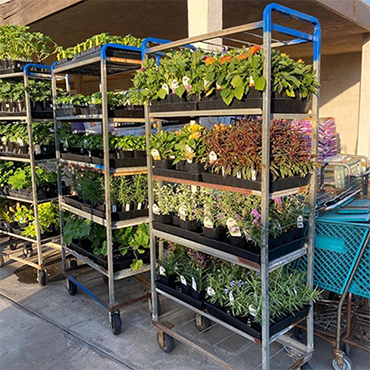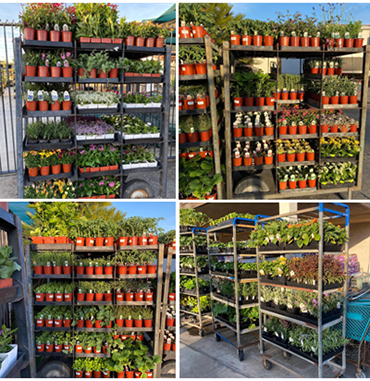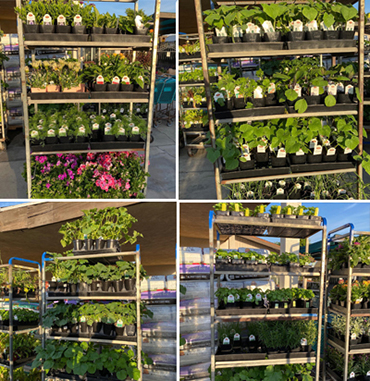Lots of vegetables and flowers available! @ Blue Hills Nursery |


 |

|
Blooming from mid-spring through early fall, the butterfly bush (buddleia) is particularly prized for its ability to attract butterflies, hummingbirds and songbirds. The most popular species originally hails from China, but buddleias are now grown throughout the United States.
Butterfly bushes are valued for their clusters of beautiful, tubular-shaped flowers. The blossoms come in a variety of colors including white, pink, red, blue, purple, orange or yellow flowers produced by different species and cultivars. Adding to their attraction is the fact that they are rich in nectar and often strongly scented.
The taller varieties add the most value to the garden when they are grown as a background shrub or as part of a mixed border, while the dwarf varieties look great as focal plants or as part of a colorful perennial bed. Butterfly bushes prefer to be planted in full sun locations but can tolerate partial shade if needed. They go completely dormant in the winter in colder areas but can remain semi-evergreen in warmer climates.
The butterfly bush is a fairly low maintenance shrub. Once established it can become fairly drought tolerant and needs only to be fed with a plant food, such as Gro-Power Flower 'n' Bloom Fertilizer once in spring and summer. It can be pruned back hard every spring if needed; this will produce a denser and more rounded shrub.
Every garden can use a few--and your birds and butterflies will thank you too!
Click to print this article. |

|
Some gardens can be pretty, some can be manicured and some can look wild and woolly, but there's nothing like a fragrance garden to tickle the nose and stimulate the senses. Fragrance gardens can be created using many different garden design themes; the only requirements are using plants with flowers or foliage that is pleasingly fragrant.
You can go Cottage, Mediterranean, Victorian, Woodland or something in between, since all can benefit from the use of fragrant plants and flowers. A fragrance garden doesn't have to be just sweet and perfumed. It can also be soothingly aromatic, with both delicate and bold scents. You can even select when you want your garden to emit its fragrance, be it morning, mid-day or night time!
Plant your garden using a good quality soil amendment like GBO Soil Building Conditioner and feed in the summer with Gro-Power Flower 'n' Bloom to ensure healthy growth. Most plants get their fragrance from essential oils in various parts of the plant foliage or flowers. Foliage fragrance is often released by touch, while flowers don't need an extra nudge to share their delights. Position foliage-fragrant plants along pathways, borders, or overhead on an arbor or trellis where their aroma will be released when you brush past them.
Some flowers can be enjoyed from far away, while others might require you to get close to inhale their sweet perfume. We're sure you'll find some scents you love among our selection.
Click to print this article. |

|
The idea behind a mailbox garden is to bring eye-catching color to the base of your mailbox, lamp post, or bird house pole. If planned properly, this garden should be able to cheerfully greet visitors season after season. For a truly spectacular garden, make sure to include plants with flowers that bloom at different seasons, cover the entire color spectrum and/or have interesting foliage or year-round interest.
It takes some pretty tough plants to put up with the harsh growing conditions surrounding a street-side mailbox. Because most mailbox locations are surrounded by pavement, this special garden takes plants that thrive in full sun and can tolerate heat and drought.
With the exception of perhaps one taller focal plant or a vine that wraps around the post, most plants in a mailbox garden should be varieties that stay under 2' in height. This way you don't block the view of your home or interfere with backing out of the driveway.
Before planting, prepare the area. Shape the bed, remove any existing weeds or sod, then dig down at least 6-8 inches and turn over the soil, mixing in a soil amendment, such as GBO Planting Mix, 50/50 with the existing soil. Add a starter fertilizer to the entire area. This will mix into the soil when you plant your plants.
Remember, it takes 3-4 months for most plants to get established. For best results, water regularly and feed every few months during the growing season with a good flower food, such as Gro-Power All Purpose and your plants will reward you with long-lasting beauty.
We have a great selection of plants perfect for mailbox gardens. Stop by for a visit and one of our staff of nursery professionals will be happy to help you make your selections.
Click to print this article. |

|
Tomato hornworms are the larvae of a large sphinx moth that is about the size of a hummingbird. In spring, the moth lays eggs on the underside of tomato (and related plants like pepper and eggplant) leaves. Although the hornworms are quite small when they first emerge, they are big eaters (of leaves) and grow up quickly. Usually, you won't even see this fellow until it is large--about 2 inches long and fat! They are quite distinctive, actually handsome with their diagonal white stripes and horns on the rear. However, due to their camoflage they can be difficult to find (until they've eaten a lot of leaves).
Don't be afraid of the hornworms. They look more frightening than they are. They don't bite or sting, just try to look big and ferocious. You can easily handpick to remove from your plants and just throw them away. When they are younger and smaller, use Bt (bacillus thuringiensis) as an effective management technique.
Some gardeners have a different approach to the tomato hornworm. While handpicking a hornworm, look to see if you find little white cocoons attached to its back. If you do see this, that cocoon is a pupating braconid wasp, which is a garden-friend predator. Capture the hornworm and keep it (or all of them) in a container, feeding them tomato leaves. You are creating a nursery for the braconid wasps that can then be released into your garden! These wasps will help control the hornworm population.
Other natural predators are birds and the larvae of the green lacewing. Plant your gardens to create an inviting habitat for all of these natural predators, and you'll control this voracious eater of your tomato leaves. Luckily, hornworms don't eat the tomato!
Click to print this article. |

|
Do ladybugs really help control bad insects?
Answer:
They sure do! In fact, ladybugs are one of the most effective predatory insects around--and love to make a meal out of bad ones. But give them time to do their thing. If you get too impatient with them, they just might "fly away home." Make sure your garden friends are happy by providing them with water and shelter. Remember that good bugs are living creatures and they have feelings too.
It is best to release them in the evening or early morning, just after you have watered the garden. This will help keep them in the garden. It is also better to release them in small batches all around your garden than in one big group; otherwise, they might get all huffy and start duking it out for the territory.
Ladybugs are more likely to remain in your garden if there is a ready food supply. It is important to provide them with an alternative food source when meals of pest insects are scarce. Flowers produce nectar and pollen, which ladybugs also need to survive. Plan your garden to feed beneficial insects by choosing a variety of plants that will bloom as many months of the year as possible.
Don't be surprised if they leave after they have removed all your bad insects, though. They will only stick around for as long as there is a good food source in your garden.
Click to print this article. |
|

|
What You Need:
- 3 red onions, diced
- 8 large tomatoes, diced
- 3 sweet red bell peppers, diced
- 2 jalapeno peppers, chopped fine
- 1/2 cup fresh cilantro leaves, chopped
- Juice of 1 lime
- Course salt to taste
Step by Step:
- Combine all ingredients in a large bowl.
- Cover with wrap and chill for 2 hours.
- Serve with choice of chips or crusty bread!

|
|
|


Whittier Weather

Contact Information:
Telephone:
(562) 947-2013
Address:
16440 E. Whittier Blvd.
Whittier, CA 90603
Hours:
Open 7 days a week, 8:30 am-5:00 pm
|
|
|





